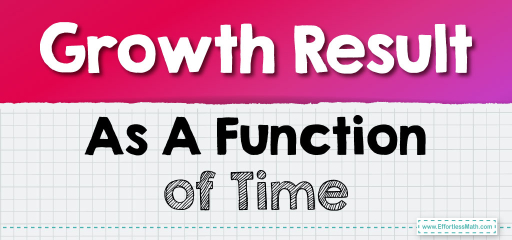Growth Result As A Function of Time
[include_netrun_products_block from-products="product/6-south-carolina-sc-ready-grade-3-math-practice-tests/" product-list-class="bundle-products float-left" product-item-class="float-left" product-item-image-container-class="p-0 float-left" product-item-image-container-size="col-2" product-item-image-container-custom-style="" product-item-container-size="" product-item-add-to-cart-class="btn-accent btn-purchase-ajax" product-item-button-custom-url="{{url}}/?ajax-add-to-cart={{id}}" product-item-button-custom-url-if-not-salable="{{productUrl}} product-item-container-class="" product-item-element-order="image,title,purchase,price" product-item-title-size="" product-item-title-wrapper-size="col-10" product-item-title-tag="h3" product-item-title-class="mt-0" product-item-title-wrapper-class="float-left pr-0" product-item-price-size="" product-item-purchase-size="" product-item-purchase-wrapper-size="" product-item-price-wrapper-class="pr-0 float-left" product-item-price-wrapper-size="col-10" product-item-read-more-text="" product-item-add-to-cart-text="" product-item-add-to-cart-custom-attribute="title='Purchase this book with single click'" product-item-thumbnail-size="290-380" show-details="false" show-excerpt="false" paginate="false" lazy-load="true"] [include_netrun_products_block from-products="product/6-south-carolina-sc-ready-grade-3-math-practice-tests/" product-list-class="bundle-products float-left" product-item-class="float-left" product-item-image-container-class="p-0 float-left" product-item-image-container-size="col-2" product-item-image-container-custom-style="" product-item-container-size="" product-item-add-to-cart-class="btn-accent btn-purchase-ajax" product-item-button-custom-url="{{url}}/?ajax-add-to-cart={{id}}" product-item-button-custom-url-if-not-salable="{{productUrl}} product-item-container-class="" product-item-element-order="image,title,purchase,price" product-item-title-size="" product-item-title-wrapper-size="col-10" product-item-title-tag="h3" product-item-title-class="mt-0" product-item-title-wrapper-class="float-left pr-0" product-item-price-size="" product-item-purchase-size="" product-item-purchase-wrapper-size="" product-item-price-wrapper-class="pr-0 float-left" product-item-price-wrapper-size="col-10" product-item-read-more-text="" product-item-add-to-cart-text="" product-item-add-to-cart-custom-attribute="title='Purchase this book with single click'" product-item-thumbnail-size="290-380" show-details="false" show-excerpt="false" paginate="false" lazy-load="true"]

What is a growth and decay model?
Simple growth and decay are mathematical models used to describe how quantities change over time. Growth equations involve a constant multiplier that increases the current value, while decay equations use a constant that decreases it. For instance, population growth often exhibits exponential behavior, where the rate of change is proportional to the current population size. On the other hand, radioactive decay involves quantities decreasing over time. These models find applications in various fields, from biology (population growth) to physics (radioactive decay) and even in everyday scenarios like carbonation loss in beverages.
Let’s take a look at some examples and their differential equations:
- Newton’s Law of Cooling states that the rate of change of the temperature of an object is proportional to the difference between its own temperature and the ambient temperature.
- \(\frac{dT}{dt} = -k(T – T_{\text{env}})\),
- where \(T\) is the temperature of the object, \(T_{\text{env}}\) is the ambient temperature, and \(k\) is a positive constant.
Original price was: $109.99.$54.99Current price is: $54.99.
- \(\frac{dT}{dt} = -k(T – T_{\text{env}})\),
- For a first-order chemical reaction, the rate of reaction is proportional to the concentration of a reactant.
- \(\frac{d[A]}{dt} = -k[A]\),
- where \([A]\) is the concentration of the reactant and \(k\) is the rate constant.
- \(\frac{d[A]}{dt} = -k[A]\),
- The growth of an investment with compound interest can be modeled by a differential equation.
- \(\frac{dP}{dt} = rP\),
- where \(P\) is the principal amount and \(r\) is the interest rate.
- \(\frac{dP}{dt} = rP\),
- The voltage across a capacitor in an RC circuit as it charges follows the equation:
- \(\frac{dV}{dt} = \frac{1}{RC}(V_{\text{source}} – V)\),
- where \(V\) is the voltage across the capacitor, \(V_{\text{source}}\) is the source voltage, \(R\) is the resistance, and \(C\) is the capacitance.
- \(\frac{dV}{dt} = \frac{1}{RC}(V_{\text{source}} – V)\),
- For an isothermal process in a gas, the pressure change can be modeled as:
- \(\frac{dP}{dV} = -\frac{nRT}{V^2}\),
- where \(P\) is the pressure, \(V\) is the volume, \(n\) is the amount of gas, \(R\) is the gas constant, and \(T\) is the temperature.
- \(\frac{dP}{dV} = -\frac{nRT}{V^2}\),
Related to This Article
More math articles
- 5th Grade NYSE Math Worksheets: FREE & Printable
- 10 Most Common 5th Grade MAP Math Questions
- 3rd Grade NYSE Math FREE Sample Practice Questions
- Unraveling the Art of Graphing: A Deep Dive into Absolute Value Functions
- Zeroing In: The Art of How to Divide Numbers Ending with a Zero
- Other Topics Puzzle – Challenge 97
- SAT Math FREE Sample Practice Questions
- How to Solve Probability Problems? (+FREE Worksheet!)
- 10 Most Common 8th Grade MEAP Math Questions
- 8th Grade MAP Math FREE Sample Practice Questions














What people say about "Growth Result As A Function of Time - Effortless Math: We Help Students Learn to LOVE Mathematics"?
No one replied yet.